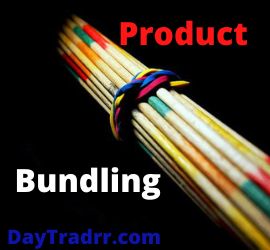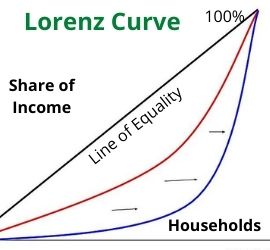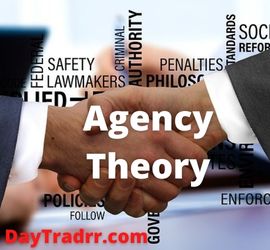What Is Product Bundling?
 Product bundling is a marketing technique where several individual goods or services are sold together as a combined package at a lower price than when purchased separately. Companies will combine multiple of their products or services into a single combined bundle. Most often, at a cheaper price than they would charge clients if they purchased each item separately. Bundled together, the items are marketed and distributed as a single unit for a single price. This method is used to persuade customers to purchase additional products.
Product bundling is a marketing technique where several individual goods or services are sold together as a combined package at a lower price than when purchased separately. Companies will combine multiple of their products or services into a single combined bundle. Most often, at a cheaper price than they would charge clients if they purchased each item separately. Bundled together, the items are marketed and distributed as a single unit for a single price. This method is used to persuade customers to purchase additional products.
A McDonald’s Happy Meal is an example of a product bundle. Instead of selling a burger, Coke, and french fries separately, they are sold as a package. Ultimately, the bundle results in higher sales than selling each item individually. Mixed product bundling occurs when a brand combines popular items sold separately into a packaged set. The bundle is usually accompanied by a bonus item or a discounted price. This way, customers can buy one or two items individually, or they can buy bundled products grouped together.
Product Bundling – A Closer Look
Bundling is a marketing approach that enables purchasing multiple products or services from a single firm. These bundled products and services are typically related. However, they can also include disparate items that appeal to a certain group of clients. Many businesses manufacture and sell a variety of goods and services. They can either sell these products or services individually at individual pricing. Or, they can offer bundles of products at a bundled price. Price bundling is becoming increasingly essential in numerous industries. For example, banking, insurance, software, and new automobile purchases. In fact, several businesses base whole marketing strategies on bundling. Bundling examples include option bundles on new cars and value meals in restaurants.
Companies using a bundle pricing scheme will sell the bundle for a cheaper price than for individual components. Offering discounts can increase demand and generate a higher volume of sales. Further, businesses can offer products or services they might not have been able to sell otherwise. Over time, this strategy may even assist to offset reductions in per-item profit margins. Face it, selling an item at a bundled discount means extracting less profit from it. Not all suppliers openly disclose if bundling is always available to their customers. It never hurts to ask to confirm whether it is an option. Especially, since bundled services frequently save consumers money.
Advantages of Product Bundling
Bundling allows a business to accomplish a lot more with its existing inventory. However, there are many other benefits of product bundling that can benefit a business.
Increase average order value
Product bundling has the potential to boost individual item profitability and sales over time. By grouping items together, a business can encourage its clients to buy more than one thing at a time. This increases the average order value. For example, instead of purchasing a single pencil, customers can be given the choice of purchasing a pencil, eraser, and sharpener as a bundle. As a result, they purchase more than one product and raise the average order value.
Decrease marketing and distribution costs
Bundling allows a company to sell more while lowering marketing and distribution costs. Rather than marketing each product individually, complementary products are bundled together and marketed as a unified product. When packaging multiple things together, a business simply needs one warehouse location to keep them instead of multiple locations. Bundling also allows a business to ship fewer boxes of different things, saving money on shipping. Instead of creating print and web ads for each individual item, they may now advertise them as a package. In turn, this helps save money on marketing while also advertising more products. For example, if a company has ten different products, it must promote and sell ten products. However, if bundled, the company can market and sell all ten as a single unit. This increases efficiency while lowering marketing and distribution expenses.
Reduce inventory waste
Unsold merchandise remains in inventory as dead stock, increasing holding expenses. Often, it is finally disposed of as waste or damaged goods. Bundling can help get rid of dead stock before it becomes a problem. Customers will regard the bundle as a deal and will be more motivated to buy. Particularly if the bundle is a slow-moving item paired with a popular, faster-selling product. This reduces inventory waste, frees up warehouse space, and lowers inventory holding costs.
Simplify the customer experience
Product bundling is a practical strategy to simplify the customer experience in addition to increasing sales and saving money. Customers have the option of selecting items or services that have been bundled with their needs in mind. Providing the ability to delete, add on, or alter products from the base bundle can increase satisfaction even further. Product bundling can also alleviate the stress associated with decision-making. While buyers like having options, having too many options can leave them feeling overwhelmed. Customers can be directed toward the types of things they are likely to be interested in. For example, online shops can put up personalized suggestions using product-consumer matching algorithms. This strategy not only alleviates buyer confusion but also assists in closing the deal.
Introduce other products
Bundling offers can assist buyers in better understanding a company’s product line. This is because they are more inclined to review or read up on each item within the collective package. Customers have more confidence in their purchases when they are more invested in the decision. They are given more control over their purchasing power.
Product Bundling Example
The bundling of goods and services is now expected by computer hardware and software companies. For example, Microsoft products are pre-installed on hard drives by computer makers such as Gateway, Dell, and Compaq. This is now an expected condition when a client purchases the product. These computer vendors also provide extra software and peripherals with new desktop, laptop, or server models as standard equipment. In addition to the purchase of a new machine, Gateway, for example, sells a package that includes a mouse, mouse pad, wrist support, and maintenance kit for roughly $10. These goods could normally cost as much as $40 if purchased separately. Software publisher Corel Corporation began combining its Word-Perfect Office Suite with a Hong Kong-based organization, PC Chips Group, in 1999. This partnership was to cater to smaller businesses searching for a computer with a huge amount of software.
Corel Corp and PC Chips Alliance
Corel Corp., the maker of the WordPerfect suite of business tools, said Tuesday it is entering a strategic alliance with personal-computer motherboard manufacturer PC Chips Group of Cos. Under the terms of the alliance, Corel’s WordPerfect Suite 8 will be bundled and shipped with every PC Chips motherboard and low-cost PC, which totals roughly 18 million annually to over 30 countries. The value of the deal was not disclosed. “This is a phenomenal opportunity which will significantly increase the penetration of our WordPerfect productivity applications around the world,” said Michael Cowpland, president and CEO of Corel. (Source: money.cnn.com)
Manufacturers of computer hardware and software bundle their products for a variety of reasons. First, a computer cannot exist without software, and vice versa. Also, consumers would prefer not to spend an additional sum purchasing these two components separately. Moreover, it is very cost-effective for both businesses to enter into agreements to co-exist with the consumer’s services. Finally, the bundling procedure gives these producers commercial awareness. Microsoft established itself as the industry standard. It combines its software with the industry’s top computer manufacturers, including IBM, Dell, Gateway, and Compaq.
Product Bundling Strategies
Bundling typically entails providing consumers with the choice of purchasing a group of things as a package. Also, at a lesser price than they would pay if they purchased them all separately. This is a practice known as mixed bundling. However, there are other variants:
Pure bundling
Customers are not given the opportunity to purchase products separately in pure bundling. A product or service that is comprised of numerous items or services must be purchased as a single item or not at all. Microsoft Corp.’s Office 365 software and television cable channel bundles are two examples. Cable providers frequently provide packages. Usually, it means customers cannot freely pick and choose which channels they wish to pay for.
New product bundling
As a promotion, newly-launched products are paired alongside existing or popular products. This strategy aims to assist shoppers to discover a company’s newest offerings. Retailers in the eCommerce space use this strategy to get attention for new products. They combine new offerings with popular, well-known merchandise. The buyer is drawn closer to the new product the more well-received the existing product is in the market. For example, one of the fastest-selling Nintendo bundles is the Nintendo Switch + Legend of Zelda product combo. In this bundle, Nintendo released brand new games that are paired together with their existing best-selling items. This package includes a one-of-a-kind traveling case, two brand new games, as well as gaming peripherals.
Cross-sell bundling
Retailers use this bundling approach to sell a complementary product as an add-on to the main product. This type of bundling is effective with lower-priced things. Or, with accessories or pieces that go with a more expensive item. For example, if you purchase a SmartPhone, you will most likely want to purchase a case as well. As a result, the SmartPhone and cover can be marketed as a product bundle.
Buy-one-get-one bundles
When you buy one primary item, you get a discount on supplementary goods or get another item for free. This is the go-to technique for one-time purchases. For example, if a customer purchases a hair dryer, they are unlikely to return and buy another any time soon. Providing a free product, discount, or gift card will encourage customers to continue shopping. All the while, they select additional things to add to their carts at a lower price.
Up Next: What Is the Gordon Growth Model (GGM)?
 The Gordon Growth Model is a stock valuation method that measures a stock’s present value by computing the future series of dividends assumed to be growing at a constant rate. The model is used to calculate a stock’s intrinsic value based on a future sequence of dividends. It is a well-known and straightforward variation of the dividend discount model (DDM). The GGM establishes a present value for an endless series of expected future payouts. It assumes that dividends will continue to rise at a constant rate in perpetuity. The model implies a continuous, steady growth rate. Therefore, it is best utilized for stable, mature corporations with consistent dividend growth rates per share.
The Gordon Growth Model is a stock valuation method that measures a stock’s present value by computing the future series of dividends assumed to be growing at a constant rate. The model is used to calculate a stock’s intrinsic value based on a future sequence of dividends. It is a well-known and straightforward variation of the dividend discount model (DDM). The GGM establishes a present value for an endless series of expected future payouts. It assumes that dividends will continue to rise at a constant rate in perpetuity. The model implies a continuous, steady growth rate. Therefore, it is best utilized for stable, mature corporations with consistent dividend growth rates per share.
The Gordon Growth Model is a prominent valuation tool. It is also one of the most widely utilized dividend discount models (DDMs). It is predicated on the assumption that a business’s dividend will rise at a constant rate in perpetuity. Therefore, it provides investors with a present value of the company based on that future sequence of payments. The approach works best with companies that have consistent dividend growth rates. For example, high dividend-yielding stocks on the Dow Jones Industrial Average.




